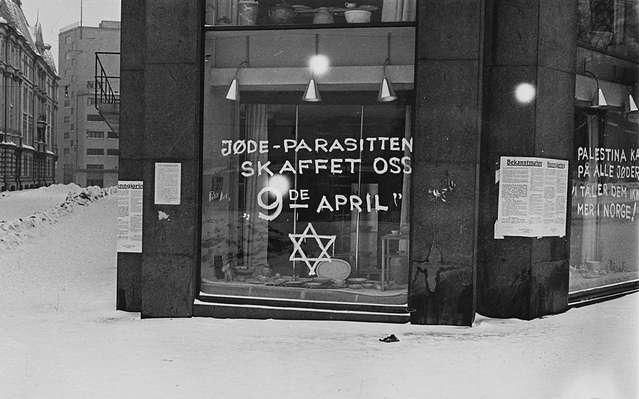Norwegian historian claims that Holocaust was planned much longer before

Anti-Semitic graffiti on a shop in Oslo in 1941. The Holocaust started earlier than usually thought, according to the historian Synne Corell. Photo Wikimedia, Anders Beer Wilse
Northern Europe
The preparations for the liquidation of the Norwegian Jews started earlier than previously thought. That's the conclusion of the Norwegian historian Synne Corell in her book "Likvidasjon" (liquidation) that was presented on Tuesday.
There were 8 million Norwegian kroner on the liquidation board's account at the end of the war. In present-day value that is 180 million kroner (18.5 million Euros). It was taken from 2,200 Norwegian Jews.
It took Dr Synne Corell three years to work through the archives and write her book. It is a story about the hunt for Jewish property. In that story, bureaucrats, bank managers, lawyers, police officers and willing customers have a place. They all participated in the confiscation of property.
Corell (1973) is known for her more critical look at Norwegian history writing about World War II. In 2011 she published her PhD research in a book about "the aftermath of war" and how history was described. Her book was published in cooperation with the Center for Holocaust Studies in Oslo.
Persecution did not start unexpectedly
In an interview in Vart Land she says that the Holocaust did not start unexpectedly with the arrest of 532 Jews in November 1942, when they were taken aboard on the Danube to be transported to Auschwitz. Even in 1940 and 1941, there were actions against Jews, like confiscating radios and the J-stamping in identification papers.
"All that was prepared and thought out before", Corell says. And above that: implementing these measures required the participation of many Norwegians. In Klassekampen, she says that the Holocaust timeline for her country has to be reviewed.
The prevailing story about the Holocaust in Norway is that the deportation was a German project that hit the Norwegians hard and was planned in a hurry. This is not true, according to Corell. She believes it becomes obvious when looking at the financial liquidation.

The financial liquidation of the Jews was a continuous part of the genocide, according to Corell. "While the deportation was hidden, the financial persecution took place completely open and was well known to many. It involved tax authorities, municipal offices, banks, insurance companies, farm managers, auction houses, transport agencies, pest control companies and more. As buyers of Jewish property, such as neighbours, workers or customers in Jewish-owned businesses", Corell explains in Vart Land, individuals also became involved in the process. The whole bureaucracy participated in the looting of the Jews.
Auctions of Jewish property well-attended
Resistance against the discrimination was very rare, the historian says. "The impression is that there was very little resistance."
A rare example of resistance is the tax manager in Bergen. At the end of October 1942, he refused to give the State Police a printout of Herschel Rabinowitz's last tax return. The tax manager was arrested. There are just a few examples of active help to the Jews.
Auctions of Jewish property are well-attended. But, as Corell points out, preferably not during daylight. Most customers came in the evening darkness.
After the war, no one asked the few surviving Jews what they had experienced. No one tried to map out the crimes they were exposed to systematically.
After 1945, many war crimes were investigated, and people were convicted. But, as Corell states: "Participation in the crimes against the Jews was usually not a charge in the cases against those who participated."
Old couple
Corell has chosen to follow a selection of Jewish families. One of them is the Karpol family. They came to the village Sør-Fron in the Gudbrandsdalen region in 1919. Their son Samuel ran the family farm for 20 years. His old parents Gerson and Jette, lived there as well. "Truly no Jew was as well integrated into a Norwegian village as the Karpol family", Corell explains.

In the 1890s, the family came from Lithuania to Norway. They lived in different parts of the country where Gerson could trade. When the children were about to start school, the family settled in Oslo. However, the family wanted to run a farm and ended up in Gudbrandsdalen.
All three siblings were killed in German captivity. In January 1943, the sick and grieving parents Jette (76) and Gerson (77) were picked up. Corell describes in detail how all the property was registered.
But when the couple was to be deported on January 24, they were taken aside on the quay by a German in uniform and released. The two returned to their farm and lived for two years after the war – rescued by a German. Nevertheless, their other properties were sold at an auction.
Corell doesn't know why the German released them. "It does not have to have been specifically humanitarian considerations behind. Both spouses were so ill, frail and old that it could just as much have been about what was practically feasible", says Corell.



